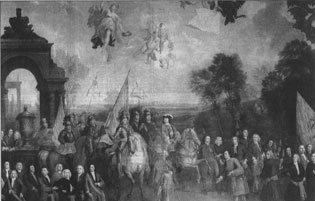King Billy and The Pope

The touring Orangemen in Stormont,
To see the picture came,
The victor of the Boyne,
Who banished Popery to shame,
But when they came upon it,
The asked how could it be:
For the pope blessing King Billy
Was what they all could see.
An outrage and an insult:
With this they could not cope,
An unholy alliance
Of King Billy and the Pope,
And so they vandalised it,
And turned in dismay,
Only to be arrested
£65 they had to pay.
To next time you meet an Orangemen
And off about the defeat of the Pope he start to coin,
Remind him both he and King Billy,
Beat King James at the Boyne!
Background:
For info on the inspiration of this poem to show the irony of the anti-Catholic usage of the Boyne commemorations (the Pope actually supported King Billy) read the article below which I reproduce from Mark Davenport of the BBC.It sits in a side room at the back of the disused Senate Chamber inside Stormonts Parliament Buildings. The painting depicts King William IIIs arrival in IrelandA monumental canvas apparently depicting the arrival of King William III in Ireland in the 1690s, it was purchased by the old Northern Ireland government back in March 1933. But the controversial work of art was vandalised soon afterwards and has not been on public display for more than 20 years. Now some say the time has come to hang it somewhere more prominent. Buying the picture, thought to be the work of William of Oranges court artist Pieter van der Muelen, cost the old Stormont government £209 and four shillings. Unionist MPs cheered when they heard of its acquisition. But those cheers gave way to bewilderment when the canvas was unveiled. There in the foreground is a figure which looks like King Billy on his white charger. But floating above him on a cloud is someone who appears to be Pope Innocent XI, apparently blessing his ally as he makes his way towards the Battle of the Boyne. A figure believed to be Pope Innocent XI appears to bless William III
For those who celebrate the victory of the Protestant King William over the Catholic King James this may be an inconvenient reminder of the facts of 17th century great power politics. But the Ulster Museums Keeper of History, Trevor Parkhill, explains that “there is a well documented record that the Pope had a Te Deum sung in the Vatican on hearing the outcome of the Battle of the Boyne”. “As Stalin would have said, they were objective allies in the 1690s against the Sun King Louis XIV who was at that time the most dominant authority in power in Europe,” he added. Back in the 1930s some couldnt stomach that kind of talk. In May 1933 a group of visitors from the Scottish Protestant League were touring Parliament Buildings when they came face to face with King Billy and the Pope. Art attack An enraged Glasgow councillor, Charles Forester, threw red paint over Innocent XI. His companion Mary Ratcliffe slashed the canvas with a knife. Both were arrested and fined £65 when they appeared in court in Downpatrick. The painting was restored for a cost of £32 and 10 shillings. The authorities at Stormont decided it would be a wise move to shift it to a less exposed spot. Its precise whereabouts inside Parliament Buildings were unknown from 1936 until 1975 when the picture was moved to the Belfast Public Record Office. It went on public display there until 1983 when it was returned to the speakers office at Stormont. Art experts dispute whether the painting is the work of Pieter van der Meulen and whether the subject really is King William of Orange. Public display But the attack on the canvas has made it part of Stormont folklore. Damian McCarney, who writes for Daily Ireland and the Andersonstown News recently had a private viewing. In his opinion, “a reproduction of it doesnt do it justice”. “Whenever you first encounter the painting you are awe struck by the size of this epic tale unfolding in front of you,” he said. “So in a visual sense it deserves to be displayed. “But I believe the story behind it will capture the imagination of a lot of people as well. “Heres a painting which attracted controversy and was attacked for no justifiable reason. “I think a lot of people can respond to that. It has echoes of the sectarian past and now were coming to a more tolerant period in history now is the time for it to be restored to its rightful place in the southern corridors of the Stormont assembly.”